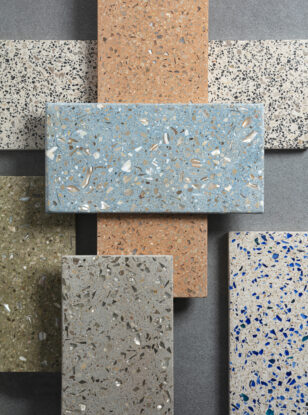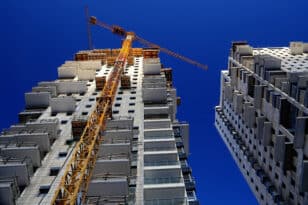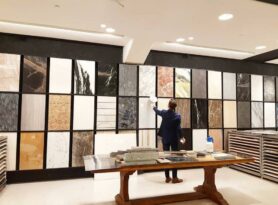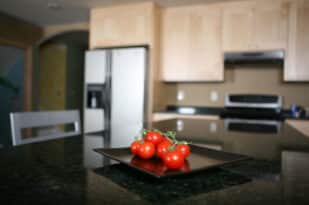Most of us cringe when we think back to those old terrazzo tiles—small, dull, and usually some uninspiring sandy color. But today, terrazzo tile is making a stunning comeback, showing up in all its glory: as smooth, seamless poured surfaces, oversized tiles, bold wall cladding, and even outdoor flooring—in just about every color you can imagine.
By Hadas Magen, Nadlan Center
Anyone born in Israel in the 1970s likely remembers that almost every apartment had the same flooring: terrazzo tiles measuring either 20×20 or 30×30 centimeters, usually in beige, with irregular speckles in various shades of brown, black, or gray. Some had lighter backgrounds, others darker, but what they all had in common was a certain unmistakable ugliness. In more upscale homes, you might have spotted a slightly more refined version with black or brown backgrounds, giving the space a somewhat more luxurious feel.
The use of terrazzo flooring was so widespread in homes of that era that it became almost synonymous with “tile.” To this day, many old, unrenovated apartments still have those original terrazzo floors. In renovated homes, however, the terrazzo tiles were usually replaced with travertine, ceramic, parquet, or the now-popular porcelain granite tiles.
But in recent years, the much-maligned terrazzo has made a stylish comeback—both as flooring and wall cladding. This isn’t the outdated terrazzo tile of decades past, but a bold new version: large-format tiles in a spectrum of colors, or sleek, seamless surfaces with no grout lines in sight. The revival has been so strong that the Ackerstein design company recently launched an outdoor terrazzo collection, following its recognition as a top trend and a favorite among designers, according to Tal Dotan Talmor, the company’s marketing and architectural planning manager.
“The old terrazzo tiles were small,” says designer Irit Harel. “Today, they come in much larger sizes, even up to a meter by a meter. Back then it was all gray and black, but now it’s vibrant—reds, blues, turquoise—and it’s used to add a bold touch to a space, like on a shower wall or a balcony.”
And what about using vintage-style terrazzo for flooring the whole house?
“Terrazzo is super practical because it doesn’t show dirt. Some people are big fans of the look—just like there are people who love those patterned tiles from the ’60s—but even they usually stick to using it in small areas, like bathrooms or balconies. I don’t know anyone who tiles an entire house in terrazzo like they used to.”
“No ceramic or porcelain tile can handle traffic and weight like terrazzo”
But Kobi Zweig, owner of the building materials company Yoska, knows people who still do exactly that. His shop continues to stock old-style terrazzo tiles in a variety of types, mostly for customers who need to replace a few after a renovation or plumbing fix. But recently, a couple came in while redoing their apartment—and the wife was set on tiling the entire home in classic vintage terrazzo.
Back in the day, Zweig says, “Middle-income families lived in terrazzo-floored apartments, while wealthier ones used marble. Terrazzo is beautiful and durable—no ceramic or porcelain can withstand the kind of traffic and weight terrazzo can. When you polish terrazzo, you get a seamless look without grout lines.”
While traditional terrazzo is made from a blend of cement and stone chips, modern versions are often composed of polymer-based materials. “It’s basically a terrazzo-look tile, imported from Italy or Spain,” explains Zweig. “It looks authentic, but it’s made from different materials.” Traditional terrazzo, adds Liat Elkabetz, Marketing Manager at the Negev Group, is crafted from a concrete base topped with pigmented textures and aggregates—those small or large stone chips embedded in the surface.
Design flexibility—blending classic and modern
Today’s “terrazzo” tiles are mostly porcelain tiles designed to mimic the terrazzo look. This has dramatically reduced the cost, says Elkabetz, and made it far more practical to maintain. “The new designs are more refined in tone and integrate beautifully into private homes. Most of what we sell for residential use is terrazzo-look porcelain. Over time, manufacturers and equipment have improved so much that porcelain tiles now look almost identical to authentic terrazzo. But like all natural materials, the real thing is still the most beautiful. There will always be those who prefer traditional terrazzo.”
According to Dudi Eliyahu, CEO of TILE, which sells a variety of tile styles, modern terrazzo mainly stands out in its finish. “Today, you can find terrazzo with a 3D effect that makes the pattern really pop from within the tile,” he says.
“The modern version of terrazzo,” says Dotan Talmor of Ackerstein, “blends classic and contemporary styles and offers design flexibility and a celebration of colors, styles, and a wide range of aggregates—marble chips, quartz, glass, or other materials embedded into the tile.”
“They’re used in many public spaces like plazas, urban squares, commercial centers, food courts, train stations, and luxury residential complexes. These tiles are slip-resistant, UV-resistant, low-absorption, and wear-resistant, making them ideal for high-traffic areas and projects that demand maximum durability without compromising on aesthetics.”
“The divine union of stone and cement”
CR Contech is a company that specializes in terrazzo pours. Even when the design mimics vintage terrazzo, a seamless pour with no grout looks entirely different—striking and unique. Company owner Gilad Naftali says they were casting terrazzo surfaces as far back as 15 years ago, including 15,000 square meters at the Teva plant in Jerusalem, and another 12,000 square meters at the Israel Museum.
For architect Uri Halevi, founder and partner at Auerbach Halevy—whose office features a black terrazzo floor—terrazzo is the real deal:
“Terrazzo is the divine union of stone and cement,” he muses. “It’s timeless, it ages gracefully, and gets better with time. Terrazzo floors have adorned Gothic cathedrals for over a thousand years and are now making a huge comeback in homes, offices, and public spaces.”
According to marketing direction Uri Ya’akovi, two years ago, terrazzo began appearing in residential spaces, and since then, top architects and designers have started to use it more and more.
For example, architect Michael Setter, who specializes in designing offices and showrooms, often uses poured terrazzo—especially in workplace dining areas and building lobbies. “Poured terrazzo gives you a smooth, seamless floor with no grout lines,” he explains. “You can design any pattern you want, in any color—small or large stones, black, white, or any other shade, matte or glossy.” Because the epoxy pour doesn’t absorb stains, Setter explains, it looks just as good years later. “With the old vintage tiles, you’d sometimes have one randomly pop out.”
While terrazzo pours are less common in homes, he recalls a recent penthouse where the floor was black terrazzo embedded with white stones. “It looked very impressive, ” he says. In certain cases, especially with retro design styles, Setter explains that designers will even use original vintage terrazzo tiles.
“You can really see that terrazzo has picked up momentum in recent years,” says Elkabetz of Negev. “If in the past it was mainly used in public spaces, today, because of all the changes it’s undergone, we’re seeing it in many private homes too—especially in bathrooms, on floors with large tiles, and even as wall cladding.”
For architect Uri Halevi, terrazzo is the real deal. “Terrazzo is the divine union of stone and cement,” he muses. “It’s timeless, it ages gracefully, and gets better with time. Terrazzo floors have adorned Gothic cathedrals for over a thousand years and are now making a huge comeback in homes, offices, and public spaces.”
Just like with marble, Halevi says, terrazzo must be carefully installed, polished, and sealed. “But in the hands of a skilled tiler, terrazzo becomes a single, stunning surface—grout-free and magnificent.”

Nadlan Center is Israel’s leading real estate news and knowledge platform in Hebrew, created for industry professionals. Founded by experts in the field, it delivers in-depth, up-to-date coverage on urban renewal, planning and construction, taxation, and housing policy — tailored to the needs of developers, investors, planners, and financiers. In addition to its widely read news content, Nadlan Center hosts major industry events, professional conferences, and training programs that support the growth and development of the Israeli real estate sector.
Learn more: https://www.nadlancenter.co.il




